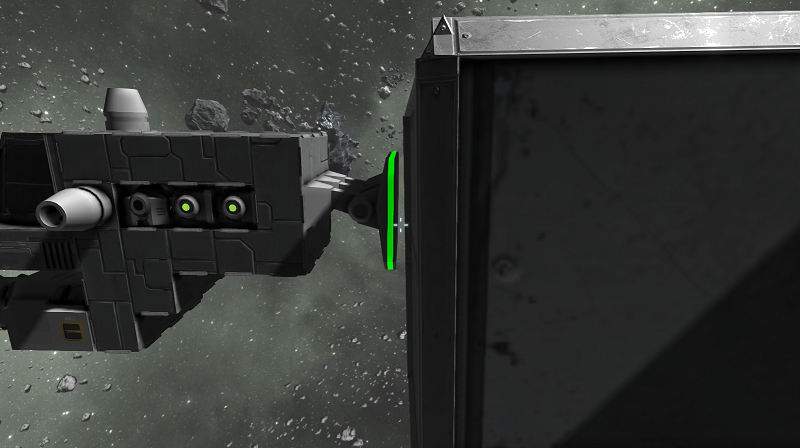Difference between revisions of "Components and Tools"
Rutakate97 (talk | contribs) m (Raised the Small Ship table limit to display all blocks.) |
|||
| Line 33: | Line 33: | ||
| ?smass | | ?smass | ||
| ?description | | ?description | ||
| + | | limit = 200 | ||
| format=template | | format=template | ||
| link=none | | link=none | ||
Revision as of 11:20, 20 September 2014
Contents
Tools
Tools are usable items with the ability to interact with the environment in different ways:
| Name | Icon | Mass (kg) | Volume (l) | Description | |
|---|---|---|---|---|---|
| Tools | 64px | ||||
| Welder (Ship) | |
Components
All components in Space Engineers are based on either the Large Block or Small Block. Large Blocks are 2.5 meters square and small blocks are .5 meters square.[1] Each components size is one or more blocks. The following blocks and tools are available in the current Alpha build of Space Engineers.
Large Ship / Station
| Name | Icon | Mass (kg) | Description |
|---|---|---|---|
| Block | 64px | ||
| Conveyor | |
524 | A multi-directional conveyor block that can transfer items between other blocks from all sides |
| Hydrogen Tank | |
||
| O2 | 64px | 2,587 | A functional structure for processing Ice into breathable Oxygen and Hydrogen. |
| Small Hydrogen Tank | |
0 | A smaller Hydrogen Tank block used to store and distribute Hydrogen. |
| Vending Machine | |
||
| Window 1x1 Side Inv | |
0 | 1x1 Inverted corner side |
| Window 1x2 Side Left Inv | |
0 | Inverted Angled 1x2 window. |
| Window 1x2 Side Right Inv | |
0 | Inverted Angled 1x2 window. |
Small Ship
| Name | Icon | Mass (kg) | Description |
|---|---|---|---|
| Conveyor | |
783 | A multi-directional conveyor block that can transfer items between other blocks from all sides |
| Hydrogen Tank | |
||
| O2 | 64px | 298.6 | A functional structure for processing Ice into breathable Oxygen and Hydrogen. |
| Small Hydrogen Tank | |
0 | A smaller Hydrogen Tank block used to store and distribute Hydrogen. |
Selected Component Details
Thrusters
Thrusters for both small and large ships require reactor energy and apply two different kinds of thrust. A thruster applies its maximum thrust while stabilizing and only 2/3 of the maximum thrust when the pilot uses W, A, S, D, or any other means of maneuvering. This means a ship will stabilize faster if the pilot does not activate any maneuvering controls.
Small Ships
| Small Ship Thruster Characteristics[2] | ||||
|---|---|---|---|---|
| Force (N) | Power (MW) | Mass (Kg) | ||
| Small Thruster | Max | 18,165 | 0.05 | 93 |
| Maneuvering | 12,000 | 0.0336 | ||
| Large Thruster | Max | 218,250 | 0.6 | 721 |
| Maneuvering | 144,400 | 0.4 | ||
Large Ships
| Large Ship Thruster Characteristics[2] | ||||
|---|---|---|---|---|
| Force (N) | Power (GW) | Mass (Kg) | ||
| Small Thruster | Max | 150,660 | 1 | 3384 |
| Maneuvering | 100,000 | 0.56 | ||
| Large Thruster | Max | 1,815,000 | 10 | 43212 |
| Maneuvering | 1,200,000 | 6.72 | ||
Reactors
Ship reactors output different amounts of power depending on reactor and ship size. While most functional blocks use some power, Refineries, Assemblers, and Thrusters are the biggest consumers of power. Note that they all have small idle power usage.
| Reactor Power Output[2] | ||
|---|---|---|
| Power (MW) | ||
| Small Ship | Small Reactor | 0.1 |
| Large Reactor | 3.5 | |
| Large Ship | Small Reactor | 5 |
| Large Reactor | 100 | |
Tips for Planning Ship Thruster-Reactor Systems
In order to avoid overusing your ship's reactors, use enough reactors to supply all of your ship's thruster's maximum power consumption.
- Take the number of small and large thrusters and multiply them by their respective maximum power (GW). This is the minimum amount of power your ship's reactors need to supply.
Landing Gear
Landing gears allow a ship to latch onto another object. They are particularly useful when docking small ships on larger carrier ships. However, when the larger ship maneuvers (especially in pitch and yaw) there is a common issue where the smaller ship's landing gear will break due to a collision error.
- In order to avoid this issue, ensure that the landing gear is not in direct contact with the metal of the carrier ship. Instead, slowly move toward the ship and attach them the instant the indicator turns yellow. This will leave some space in between the two ships, and keep the collision error from occurring.
References
- ↑ http://steamcommunity.com/app/244850/discussions/0/810939351168363653/
- ↑ 2.0 2.1 2.2 Measured in-game
